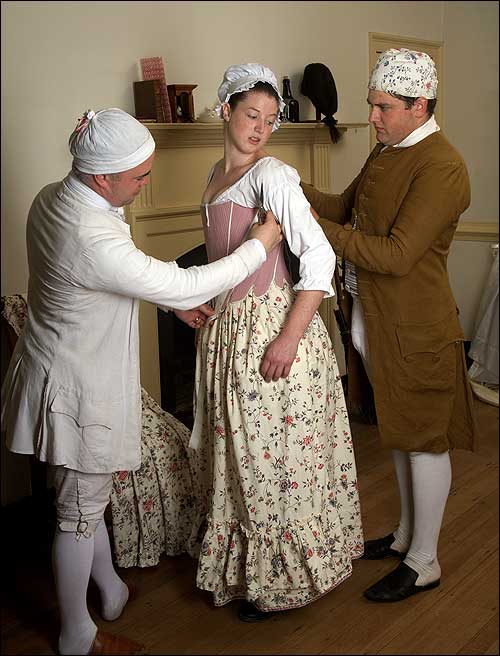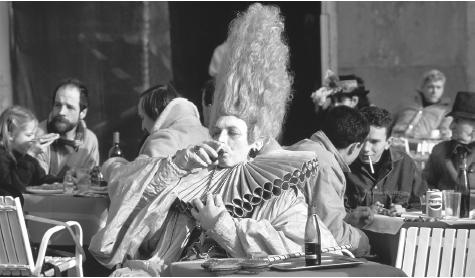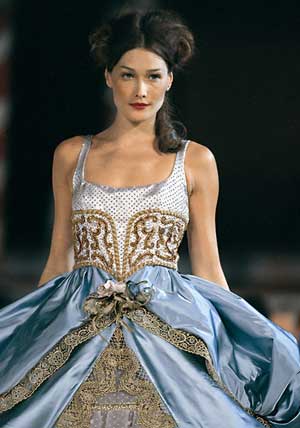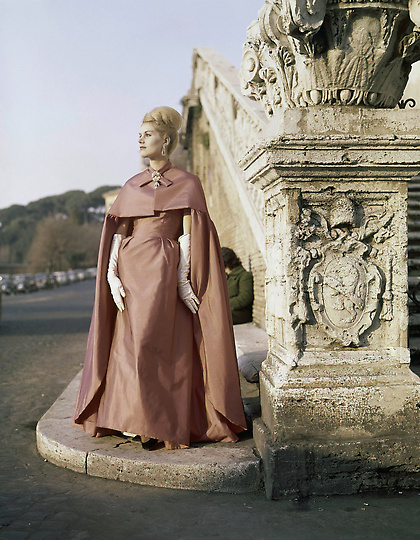source(google.com.pk)
Italy Traditional Dress Biography
The areas of major interest within the Italian tradition are undoubtedly Dignano, Gallesano, Valle. In these centres there was a particular way of dress for women which existed up until the 1870’s-1880’s when it was quickly replaced by the bourgeois fashions. The pieces that still exist are from the area of Dignano. Aside from the pieces on display in Vienna, there are also pieces of the traditional costume on display in the Museum of Pisino. These pieces are questionable since they might have been recreated for a folklore group in the period between the two world wars. As previously noted there are still some pieces of clothing will still exist from Gallesano. This picture made complete by two statues in the museum in Rome which represent women from Valle and Dignano.
The ladies’ blouse ‘cam?isa’ was worn close to the skin and covered from the shoulders to the knee. It was also considered an undergarment. The version of the blouse that was worn daily was made from a hemp material. The sleeves were made of linen or a bonb?s cotton. The version used for more festive occasions was made of a more delicate cloth. The neckline had a ruffle which was sometimes decorated with lace. The sleeves were gathered at the wrists. The sample found in the museum in Vienna was made of 4 square pieces of fabric: one each for the front and back and one for each of the sleeves. Each of the four pieces came together at the neckline. Two folded square pieces of fabric were inserted in the armpits. Down from the waistline a ‘carpita’ slip of a green, red or blue cloth was gathered at the waist and long to one’s feet. It was decorated at the seam with lace made of silver thread called rumana (romana). Later, this slip was made of a white fabric. Undergarments became more prevalent from the middle part of the 1800’s: a sleeveless girdle ‘bustin’ and underwear ‘mudande’ which went halfway down the leg and had an opening in the crotch. On top of the blouse a sleeveless bodice ‘camisul?in’ was worn. The everyday version was made of a dark wool and the festive version was of a red cloth (black for the older women). It was lined with a white cloth. On top, the petticoat had a rounded neckline and each side was hooked or overlapped and pinned together. The example from the Gallesano area is longer and has a more squared neckline. The locally made ‘soca’ or ‘suoca’ skirt was of a black wool (gurgàn, gorgàn, grogano, or grossagrana). It could also be bought camlet. The Istro-Romance term soca corresponds with the Istro-Croatian term sùknja. Back in the 12th-13th centuries the term came from Poland and made reference to a woman’s dress. It is also known as suckenie in Germany and sousquanie in France. Suchigna cloth was noted in the medieval statutes of Trieste and Capodistria. The soca skirt was gathered at the waist and long to the ankles. The gurgàn socas usually had a red or turquoise seam. The example in the museum in Vienna is made of seven pieces of cloth, one which was laid flat in the front while the other six were pleated on the sides and back. The front flat panel was sewn together in two places while the other six had holes in them through which a drawstring was pulled.
For more festive occasions women would were a lower bodice ‘brasarola’ which had detachable sleeves. Usually the two pieces were made of a similar fabric and were inseparable. In Dignano and Gallesano the brasarola was made of two rectangle pieces of silk brocade or a red or green damask that was 10-12 cm wide. The two pieces were connected by matching white or colored ribbon. Each piece was lined with a white fabric and hemmed with a white or red ribbon on three sides while the fourth and lower side had a white 4-8 cm wide hem. Usually the brasarole were trimmed on three sides with silver thread. They were held up by colourful ribbon called ‘spalari’. In Valle the brasarola was a bit higher and had shoulders made of similar fabric. According to Rismondo, in Dignano the brasarola was worn on top of the camisul?in. The term bracciaiola refers to a sleeve or cuff but can also refer to a rectangular handkerchief.
On top of the skirt was a ‘travesa’ apron (Veneto traversa), which on festive occasions was made of black silk or a dark purple or green satin. In the winter, in place of the brasarola and sleeves a gh?lero (a jacket of made of a brown woolen cloth and trimmed with black fur) was worn. Hairdos were carefully groomed. There were women who specialized in hairdos and they would do house calls. The hair was divided into four sections and each had a double part. In the back two braids were gathered by a black silk ribbon and done up in a bun at the nape.
Many hairpins of various shapes were placed in the bun. The more simple versions had an ornamental ball, or bird or ear cleaner pins with an oval end. The silver pins, usually about twelve, were arranged in a fan-like fashion and combined with other pins of various designs. The more wealthy ladies would have as much as twenty-four pins which are considered a full set. If the number of ornamental pins was limited this would be considered a half set. The ‘planet’ was considered the biggest pin with a large head and with various branches extending from it. The ‘pianetole’ had a little globe on top while the ‘spadèini” had a handle grip end. The ‘trèmuli’ were pins with a spiral tip that had a flower attached to it which would bob about as one walked. In Dignano the women would wear a rigid black woolen hat as sign of mourning and as a protective covering from the sun. The hat was low, with a wide brim and around it was black ribbon tied on the left hand side with a bow. There are no known examples of this hat in circulation.










Italy Traditional Dress Biography
The areas of major interest within the Italian tradition are undoubtedly Dignano, Gallesano, Valle. In these centres there was a particular way of dress for women which existed up until the 1870’s-1880’s when it was quickly replaced by the bourgeois fashions. The pieces that still exist are from the area of Dignano. Aside from the pieces on display in Vienna, there are also pieces of the traditional costume on display in the Museum of Pisino. These pieces are questionable since they might have been recreated for a folklore group in the period between the two world wars. As previously noted there are still some pieces of clothing will still exist from Gallesano. This picture made complete by two statues in the museum in Rome which represent women from Valle and Dignano.
The ladies’ blouse ‘cam?isa’ was worn close to the skin and covered from the shoulders to the knee. It was also considered an undergarment. The version of the blouse that was worn daily was made from a hemp material. The sleeves were made of linen or a bonb?s cotton. The version used for more festive occasions was made of a more delicate cloth. The neckline had a ruffle which was sometimes decorated with lace. The sleeves were gathered at the wrists. The sample found in the museum in Vienna was made of 4 square pieces of fabric: one each for the front and back and one for each of the sleeves. Each of the four pieces came together at the neckline. Two folded square pieces of fabric were inserted in the armpits. Down from the waistline a ‘carpita’ slip of a green, red or blue cloth was gathered at the waist and long to one’s feet. It was decorated at the seam with lace made of silver thread called rumana (romana). Later, this slip was made of a white fabric. Undergarments became more prevalent from the middle part of the 1800’s: a sleeveless girdle ‘bustin’ and underwear ‘mudande’ which went halfway down the leg and had an opening in the crotch. On top of the blouse a sleeveless bodice ‘camisul?in’ was worn. The everyday version was made of a dark wool and the festive version was of a red cloth (black for the older women). It was lined with a white cloth. On top, the petticoat had a rounded neckline and each side was hooked or overlapped and pinned together. The example from the Gallesano area is longer and has a more squared neckline. The locally made ‘soca’ or ‘suoca’ skirt was of a black wool (gurgàn, gorgàn, grogano, or grossagrana). It could also be bought camlet. The Istro-Romance term soca corresponds with the Istro-Croatian term sùknja. Back in the 12th-13th centuries the term came from Poland and made reference to a woman’s dress. It is also known as suckenie in Germany and sousquanie in France. Suchigna cloth was noted in the medieval statutes of Trieste and Capodistria. The soca skirt was gathered at the waist and long to the ankles. The gurgàn socas usually had a red or turquoise seam. The example in the museum in Vienna is made of seven pieces of cloth, one which was laid flat in the front while the other six were pleated on the sides and back. The front flat panel was sewn together in two places while the other six had holes in them through which a drawstring was pulled.
For more festive occasions women would were a lower bodice ‘brasarola’ which had detachable sleeves. Usually the two pieces were made of a similar fabric and were inseparable. In Dignano and Gallesano the brasarola was made of two rectangle pieces of silk brocade or a red or green damask that was 10-12 cm wide. The two pieces were connected by matching white or colored ribbon. Each piece was lined with a white fabric and hemmed with a white or red ribbon on three sides while the fourth and lower side had a white 4-8 cm wide hem. Usually the brasarole were trimmed on three sides with silver thread. They were held up by colourful ribbon called ‘spalari’. In Valle the brasarola was a bit higher and had shoulders made of similar fabric. According to Rismondo, in Dignano the brasarola was worn on top of the camisul?in. The term bracciaiola refers to a sleeve or cuff but can also refer to a rectangular handkerchief.
On top of the skirt was a ‘travesa’ apron (Veneto traversa), which on festive occasions was made of black silk or a dark purple or green satin. In the winter, in place of the brasarola and sleeves a gh?lero (a jacket of made of a brown woolen cloth and trimmed with black fur) was worn. Hairdos were carefully groomed. There were women who specialized in hairdos and they would do house calls. The hair was divided into four sections and each had a double part. In the back two braids were gathered by a black silk ribbon and done up in a bun at the nape.
Many hairpins of various shapes were placed in the bun. The more simple versions had an ornamental ball, or bird or ear cleaner pins with an oval end. The silver pins, usually about twelve, were arranged in a fan-like fashion and combined with other pins of various designs. The more wealthy ladies would have as much as twenty-four pins which are considered a full set. If the number of ornamental pins was limited this would be considered a half set. The ‘planet’ was considered the biggest pin with a large head and with various branches extending from it. The ‘pianetole’ had a little globe on top while the ‘spadèini” had a handle grip end. The ‘trèmuli’ were pins with a spiral tip that had a flower attached to it which would bob about as one walked. In Dignano the women would wear a rigid black woolen hat as sign of mourning and as a protective covering from the sun. The hat was low, with a wide brim and around it was black ribbon tied on the left hand side with a bow. There are no known examples of this hat in circulation.
Italy Traditional Dress

Italy Traditional Dress

Italy Traditional Dress

Italy Traditional Dress

Italy Traditional Dress

Italy Traditional Dress

Italy Traditional Dress

Italy Traditional Dress

Italy Traditional Dress

Italy Traditional Dress

Italy Traditional Dress
The Prom Dress is pretty. Big Red flowers print is making it more centre of attraction.
ReplyDeleteAgenzia hostess milano